You are reading the older HTML site
Positive Feedback
ISSUE
22
The Rocky Mountain Audio Fest: A Photo Essay,
Part 2
by David W. Robinson
[All photographs and image processing by Robinson]
Days two and three were every bit as busy as I thought they'd be. We were up and hit breakfast first thing…I've got to have that java before prowling the halls of audiophiledom. Dave, Carol, Bryan, Lila, and I set out our plans for the day, then hit the trail.
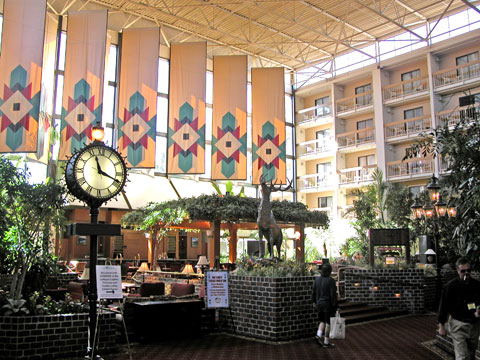
The atrium at the Marriott Tech Center, the site of The Great Divide restaurant and tavern is an attractive setting. This is a great place to hang out with audiobuds, which is what many of us did during breaks.
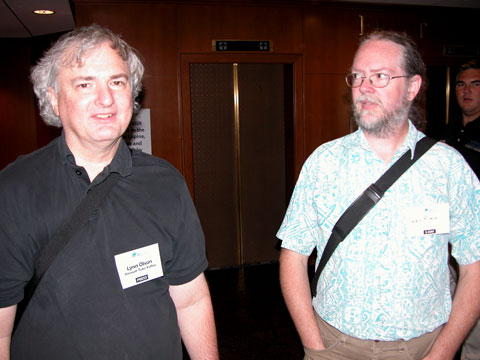
While crossing the lobby on my way to the rooms, I ran into Lynn Olson of PFO and VTV, as well as the Portland audio designer Gary Pimm. These gents were last seen in the pages of Positive Feedback Online in Issue 20; see "Gizmo Lives" at https://positive-feedback.com/Issue20/olsenkarna.htm. These are two exceptional audio artisans …check out this article.
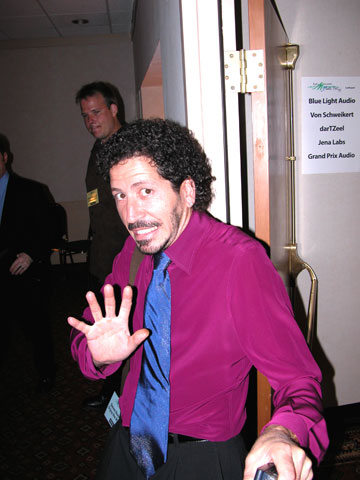
Yoicks! Who be that?! Why, it's none other than my man Mr. Stevie-o Rochlin, editor of enjoythemusic.com. He was fresh in from the Ferrari track scene; I saw him just outside the Blue Light/Von Schweikert/EMM Labs/darTZeel/JENA Labs/Grand Prix Audio room. Usually Steve and I get to have a cigar together; somehow or the other, we weren't able to make the holy smoke this year. Perhaps next year, amigo….
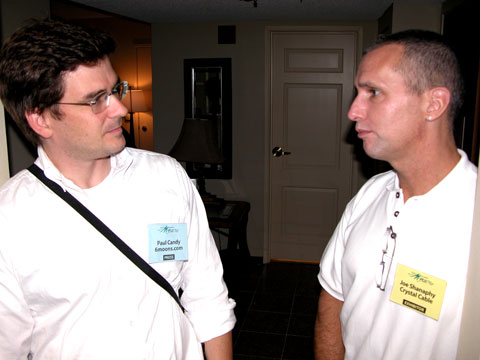
I ran into another couple of acquaintances upstairs in the halls: Paul Candy of Srajan Ebaen's fine publication, sixmoons.com, chatting with Joe Shanaphy of Crystal Cable.
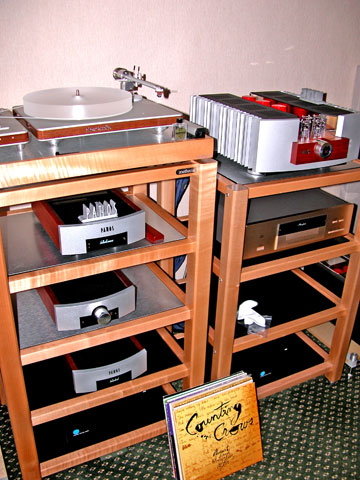
Now here's a room that I enjoyed for a while on Saturday: the Audio Unlimited/JM Lab/Focal/Pathos Acoustics/Kubla Sosna Cables space. Featured was Pathos electronics, a Clearaudio table and cartridge, and Accuphase for CDs. The room wasn't very large, which is usually a bad thing at shows, but this system was always musical. Thanks for Art Manzano for playing the DJ while I was there.
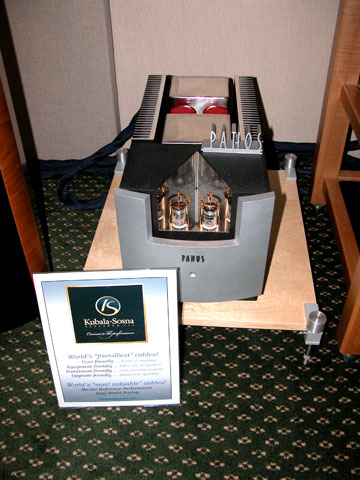
The Pathos InPower monoblock was driving the Tannoys while I was there. 80 watts per side, and sounding quite good under show conditions.
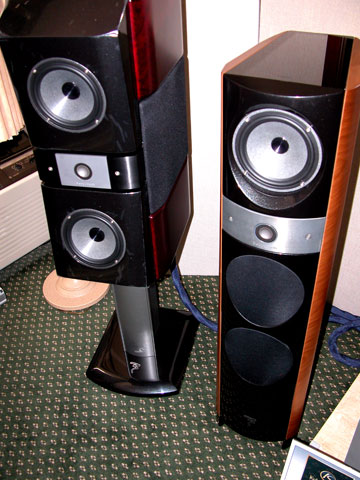
I have to admit that the JM Labs speakers in this room were sounding better than many of their speakers have under show conditions in the past. Tonally they were quite clean, and didn't sound hi-fi-ish as they have to my ears in some venues that I've heard them in. The synergy was certainly better here, anyway—and that in a small room.
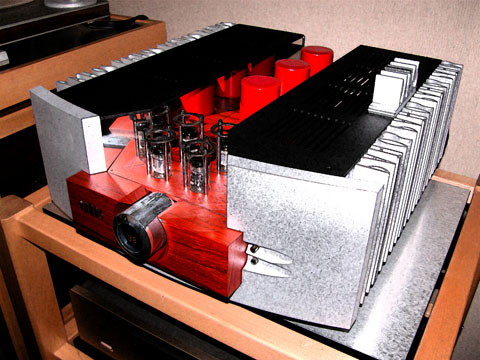
The Pathos InPol2 Integrated Balanced amplifier, in fresco: beautiful to look at, surely. I didn't get a chance to hear it, but I didn't want you to miss seeing it.
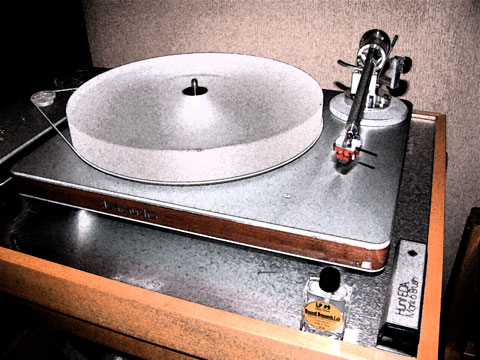
While I'm in a fresco mood, here's the Clearaudio turntable that I heard. I didn't get the model …perhaps Garth will let me know which one this was. Whichever it was, its playback was pleasant.
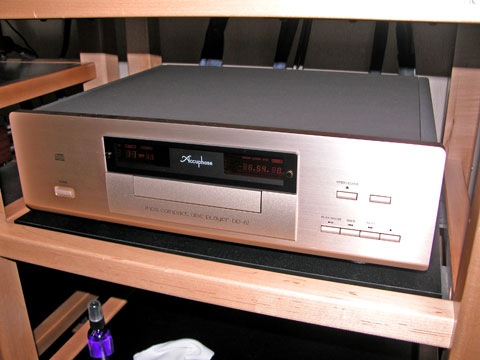
The Accuphase DP-67 CD player sounded very decent in this system.
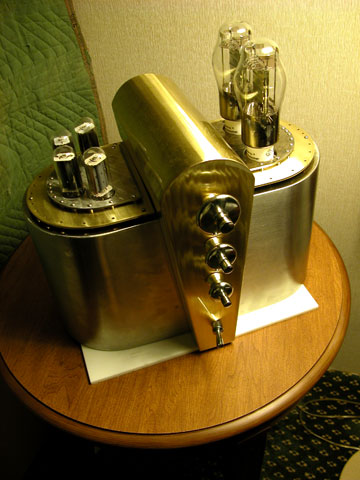
You know, I just had to stop in The Dowdy Lama/Electronluv room to see what Josh Stippich has been up to lately.
Yep, Josh has been playing again.
Me, I think his work belongs in NY's Museum of Modern Art.
Heck, and it plays music, too!
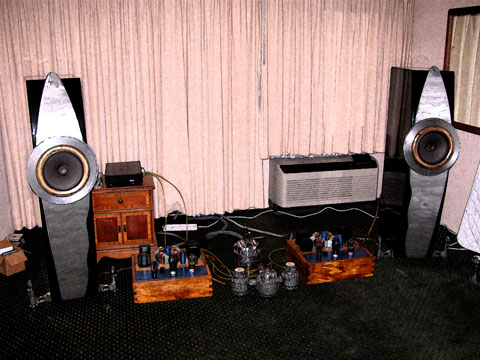
A fresco of The Dowdy Lama/Electronluv system …way cool on the eyes. Show conditions made it hard for me to assess the sound, though.
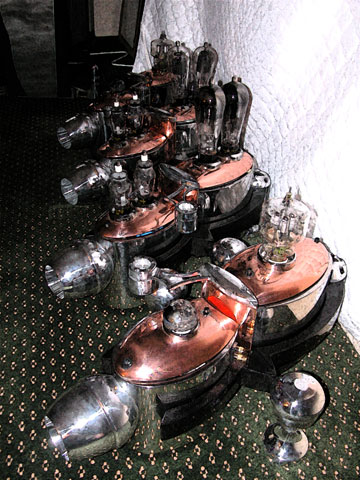
Electronluv "piggies on parade." Josh is the Tim Burton of fine audio….
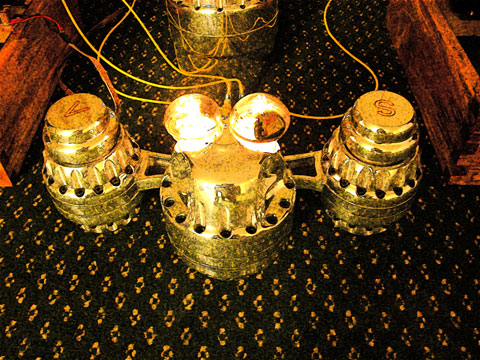
Another Electronluv fresco: it's a preamp! No, it's an amp! No, it's an iron butterfly!
Hmmmm. I've got to quit drinkin' that stuff….
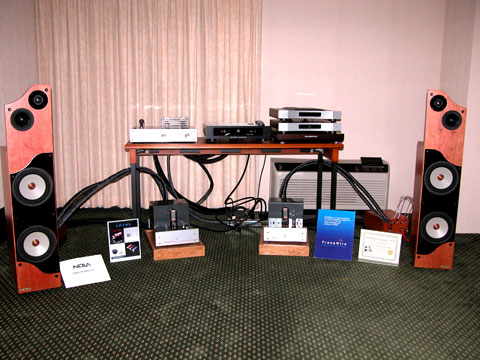
Here was another very musical room: the deHavilland/Nola/Pranawire room. The Nola speakers were sounding quite good being driven by a pair of the deHavilland GM-70 monoblocks, and connected by Joe Cohen's Pranawire cables. The pre was a deHavilland Mercury II, as I recall; the digital was by Metronome Technologie. I have to confess that I prefer the deHavilland room with open reel tape or SACD or a turntable, but do confess that the room sounded good.
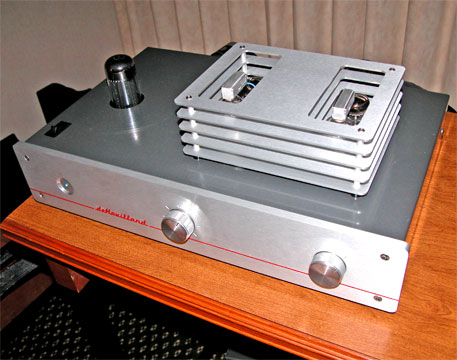
Here's the deHavilland Mercury II preamp …truly a fine pre. Kara and George do superb work…
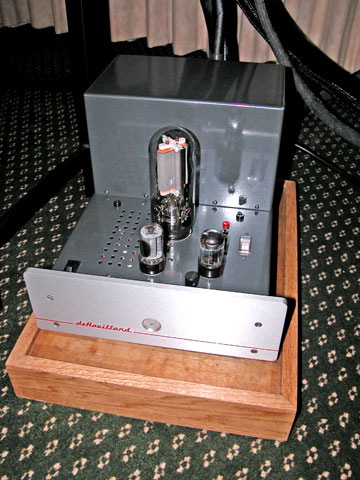
…as you can see in this photo of the GM-70 monoblock amplifier. They do look better with the shields in place, but sound terrific, regardless.
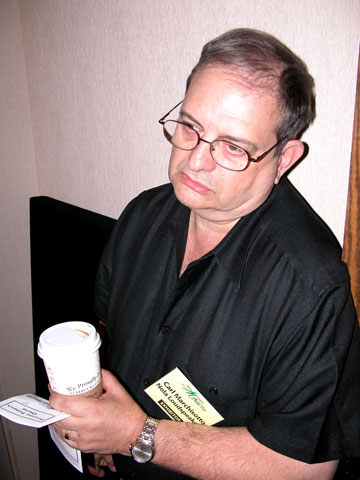
As a matter of fact, the sound in the deHavilland/Nola/Pranawire room was inviting enough to draw me into a conversation with Carl Marchisotto of Nola. I was impressed by Carl's passion and enthusiasm for fine audio—we need more of this!
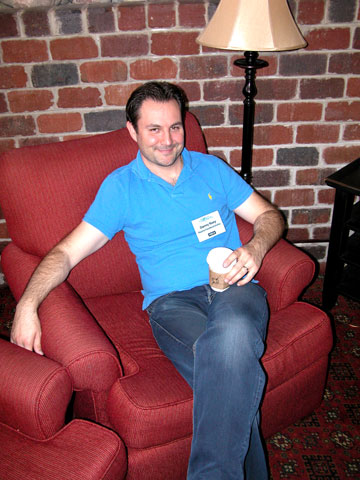
It was time for a break down at The Great Divide. I ran into PFO's Danny Kaey quaffing a java…
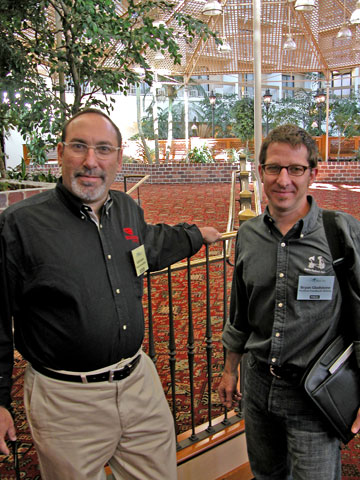
…while right around the corner Garth Leerer of Musical Surroundings and PFO's Bryan Gladstone were yakkin' it up. That's one of the really enjoyable things about RMAF: there's time to talk. And if you don't think that meeting friends and enjoying the time with people is important, then, my friend, you haven't been to many fine audio shows.
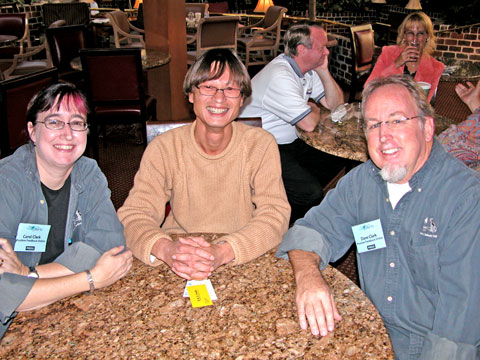
Speaking of good folks, Carol and Dave got a chance to chat with Tri Mai of Triplanar. Tri is a delight to meet, and produces a fine tonearm, to boot. Tri is always very friendly, cheerful, and a lot of fun to talk with. We always enjoy his company.
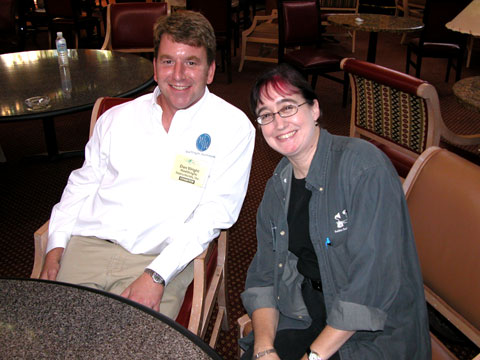
Dan Wright of Modwright also dropped by and visited with Carol and Dave Clark. Dan is an excellent audio designer, now moved from Portland up to Amboy, Washington.
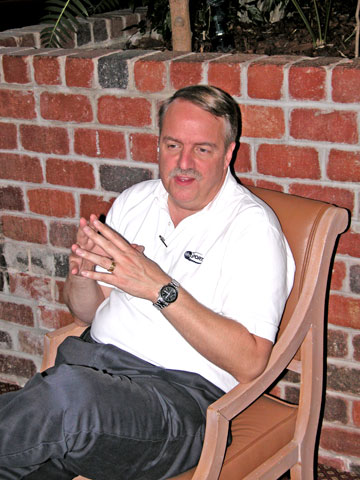
Lo! And Behold! None other than PFO's Mike Pappas, DSD and audio engineer extraordinaire dropped by to shoot the breeze with us. Mike's been a friend and a member of the PFO community for a lot of years now ...what, 11 years? 12 years? He reminded me that he was running his DSD surround demo …I had to check it out.
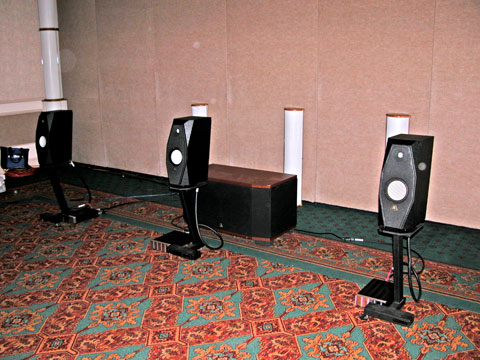
Which I did immediately afterwards. Once again Mike was using a front array of three Avalon monitors (left/center/right) with ceramic mids, two more of these in the rear for left/right, the trunk-sized Avalon subwoofer (which reaches down to about 10Hz), Rowland electronics, Cardas cabling, and EMM Labs/Genex at the front end. The recordings were a series of pure DSD projects that he had engineered over the past few years, all of which were exceptional. They ranged from big band to vocal to an organ recording in a venue with a nearly five second decay. Bloody wonderful, Mike!
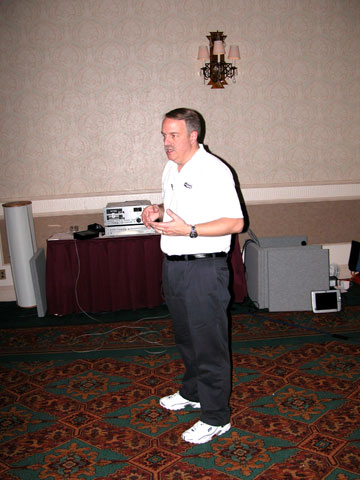
Before each recording, Mike talked about what the music involved, how it had been recorded, and what we should expect to hear. When it's the audio engineer who did the work, one should pay attention. The sense of spaciousness and natural decay in Mike's work is phenomenal, and show the possibilities of DSD surround as the best method yet to deliver a soundfield, as opposed to merely the soundstage of stereo.
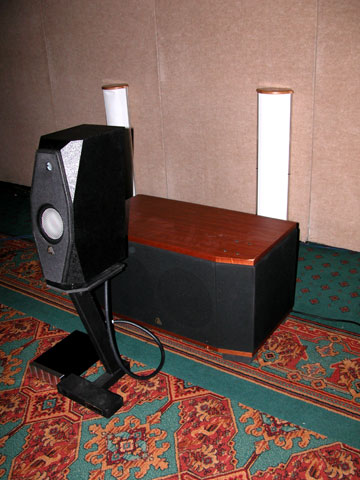
A closer look at the Avalon monitor and subwoofer.

After Mike finished his presentation, I was very pleased to finally get a chance to hear Ray Kimber present some of his IsoMike recordings. Ray's done this demo in shows before, but I had missed them. Now I was able to extend my audio education to include Ray's approach to microphony and DSD surround sound.
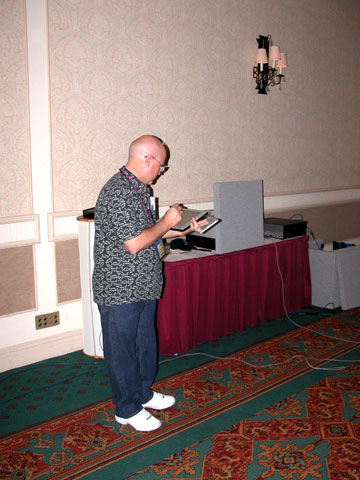
Ray controlled playback with a wireless touch pad; the results were superb. The recordings included choral presentations, and some stringed recordings. The sense of spaciousness and atmosphere was quite fine; one felt the choral performers to be in the room around the audience. I salute Ray for his work with the IsoMike technology; I think that it shows outstanding promise for the future of fine recordings. (For more about the IsoMike system, see the Kimber site at http://www.kimber.com/IsoMike/Default.aspx.) His SACDs are not to be missed, either …I was impressed by them when I got them home and spent a while twirling them. There's some real magic here!
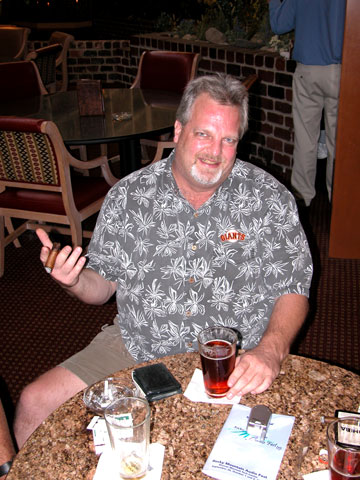
By the end of the two DSD surround presentations, I needed a fine libation—time to go back to The Great Divide! When I arrived there, I ran into my good audiobud Brian Hartsell of The Analog Room in San Jose. (http://www.theanalogroom.com.) Brian is a former contributor to Positive Feedback, and truly authoritative on LPs, record collecting, vinyl playback, and "what sounds good." (Answer: SME 30/2A with the top grade Koetsu cartridge that you can only afford if you have access to a sizeable trust fund. Ain't it always the way?)
I'll let you in on a secret: if you want to know what's really great on vinyl, if you'd rather not noodle around with secondary sources in, say, Stereophile or TAS, you can save yourself a lot of time and effort by going straight to Brian.
Doubt me? Try it. Just make sure that you have your checkbook with you…he's got the righteous stuff, mon!
Heck, the guys who are supposed to know vinyl go to him for the real scoop.
Anyway, I hadn't seen Brian for a couple of years, so we had a long conversation …in two parts (early and late)…that lasted for hours. Records, reissues, the people who get it, the people who don't get it, the people who are never going to get it, turntables, cartridges, phono amps, mastering engineers (Stan Ricker's name came up a LOT!), and so on. You know, a tape of that conversation would be incriminating—but a heckuva lot of fun to listen to! And as we talked, another "PFO and friends gathering" happened …the usual slow motion accretion of people that I enjoy so much….
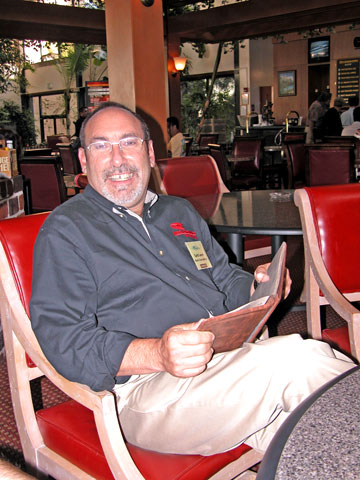
For example, Garth Leerer of Musical Surroundings (http://www.musicalsurroundings.com) sat down to have a drink and talk vinyl—no surprise! I have come to have a lot of respect for Garth's dedication to fine turntables, and hope to do a review of one of the Clearaudio reference tables next year. Needless to say, any table that has Brian Hartsell, Garth Leerer, and yours truly sitting at it, microbrews in hand, is a jolly one!
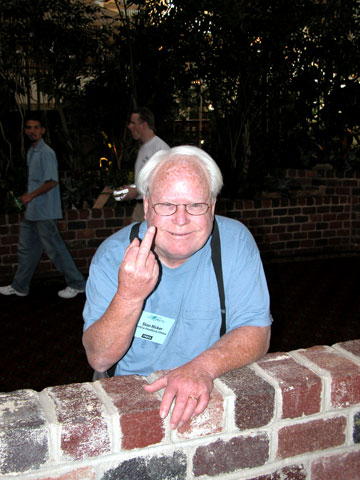
Speaking of jolly …speaking of "Stan Ricker"…none other than the Great One dropped in to the growing party! Here we have Stan in a characteristic pose, in which he tells us what he thinks of "the people who don't get it," and especially what he thinks of "the people who will never get it"! Somehow or the other, Stan had been passed over for the RMAF panel on vinyl and LP playback(!!!) Thankfully, Brian Hartsell and others in that seminar were able to pull Stan out of the crowd an into action. Chillun, Stan has forgotten more about LP mastering than most people in the biz even know. He's the Dean, "Stan the Man," the gent who should be mastering a HECKUVA lot more LPs than he's doing these days. I've got to wonder what some of the audiophile labels are thinking about, when they bypass using a true, proven master of the format.
Then again, maybe they aren't thinking. Nothing surprises me in the sometimes bloody fishy small pond of fine audio.
But allow me to suggest publicly that the audiophile labels ought to be getting off their collective backsides and sending more of their critical work to Stan.
We'd all be better off.
End of rant.
Anyway, I am glad to say that by Sunday, this egregious oversight had been remedied, and Stan was formally on stage as the master he is.
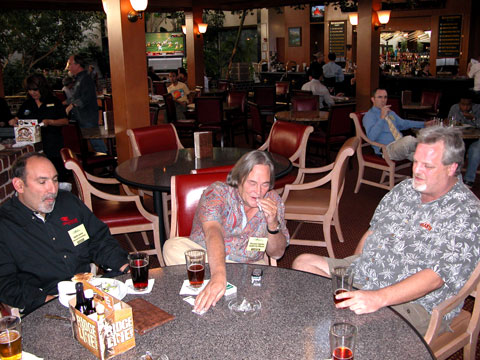
The party grew; Garth (left) and Brian (right) were joined by long-time friend and vinyl lover Ronnie Caplan (center).
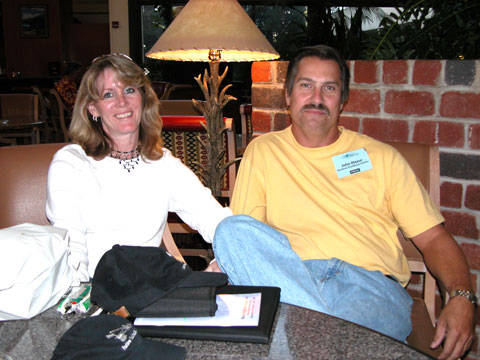
PFO contributor John Mazur and his wife joined us shortly thereafter; it was my first chance to meet them face to face. John's a good fellow.
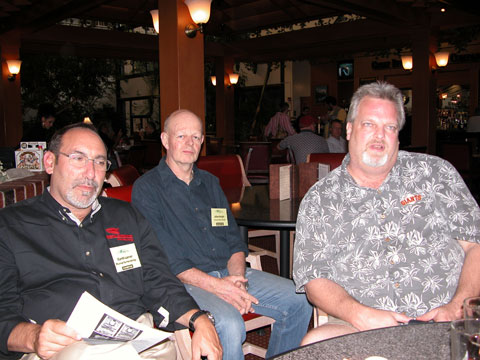
Also dropping in was another master of fine audio, Allen Wright of Vacuum State Electronics (center). Allen is a PFO Brutus Award winner for his work in modifying SACD players. If you want to hear a modded SACD player that gives you a goodly portion of the quality of sound that the EMM Labs gear delivers, check out Allen's Level Five mods. (http://www.vacuumstate.com) Allen is a brilliant fellow, a great conversationalist, and a good audiobud of mine. As a matter of fact, PFO's Danny Kaey and I spent quite a while in a private conversation with Allen, while he explained his take on DSD, and how he approaches the modification of SACD players. Danny became quite enthused about DSD as a result, and is now hooked up with a Vacuum State Electronics SACD player.
You know, we're just starting to understand the possibilities of DSD and SACD playback. Doubters, nay-sayers and gloom merchants: you're really missing the boat. (No, don't argue. Just get on the boat.) I've said it before, and I'll say it again (as I sit here listening to Miles Davis' In a Silent Way on Japanese SACD via EMM Labs CDSD/DAC6e, Wavac PR-T1 pre, Red Rock Audio Renaissance amps, Von Schweikert VR-9 SE speakers, all improved with Walker Audio E-SST and HDLs):
We have only two reference quality sources…fine LP playback, and fine SACD playback.
(I'd include open reel, of course, but it isn't widely available.)
If you don't have these two, then you're missing out.
(Clark Johnsen claims that CD's may have finally reached the threshold of acceptability—at last—via the RealityCheckCD™ process of George Louis. Check out his intriguing articles elsewhere in this issue at Issue22 - cjdiariess; see also his earlier column on the subject in PFO Issue 21 at Issue21 - cjdiaries. My own personal jury is out on this one …I haven't heard the RealityCheckCD™ process myself…and the claims of "better than SACD" as practiced here in my listening room I doubt immensely [pace, Clark!]…but if George Louis sends one along, I'll gladly give it a try.
We now return you to your regularly scheduled programming….)
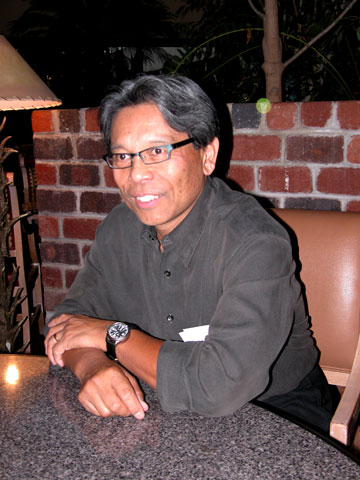
Next thing you know, Art Manzano of Axiss Distribution dropped by our table. Art carries some good lines (e.g., Transrotor, Air Tight, Accuphase …see his site at http://www.axiss-usa.com), and has been an audiobud to PFO for years. It was good to see him again.
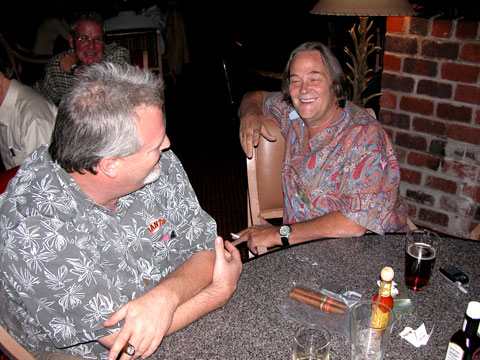
I went through a couple of pints of Butt Head Bock, my personal fave brewski of RMAF 2005, while our table talked into the night. Later, I brought down a smashing single malt, the Caol Ila Murray McDavid 1989, which I shared with Brian Hartsell, another single malt fancier. (There are a lot of single malt lovers in fine audiodom, I find.) Things were mellow, for sure. Above, Brian and Ronnie enjoy the moment…
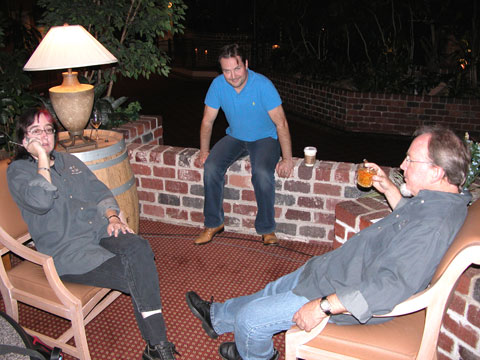
…while to my right Carol, Danny and Dave relax after a long day of audio touring.
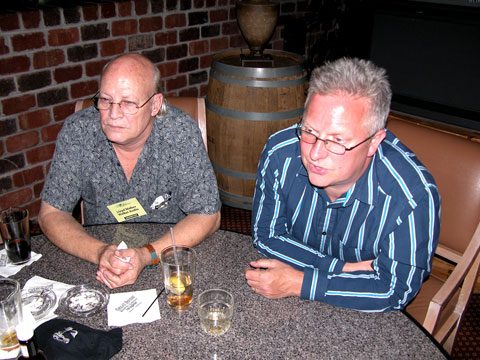
Yoicks! Better and better! Lloyd Walker (left), the turntable design genius behind Walker Audio's Proscenium Gold Signature, etc., etc., drops in for a drink with his new British distributor, Chris O'Donoghue, of Audiophilia in London. (Brit turntable lovers, take note!) Let's just say that the turntable conversation got pretty lively at this point….
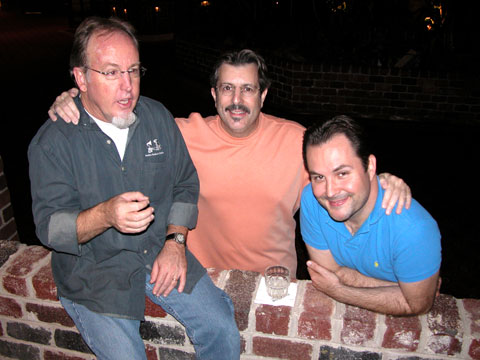
Dave Clark, Alan Kafton, and Danny Kaey, good friends all.
I was up until nearly midnight, making the Murray McDavid last as long as possible, before Brian Hartsell, Ronnie and I, having finished a late conversation with Chad Kassem of Acoustic Sounds, called it a night.
A very long day, amigos.
The third and last day of the show was hurried, as happens all too often. No time to decompress, no time to hear or re-hear every room that I would have liked to have done. Robinson's Rule of Audio Shows: No matter how many days they last, they're always too short by at least one day.
I did the best I could with the time I had.
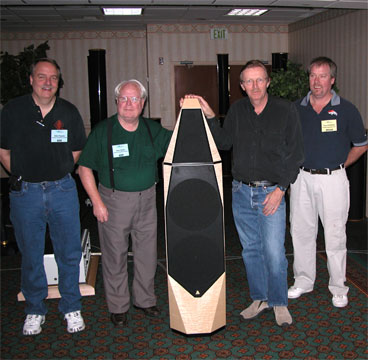
In the morning, Mike Pappas, Stan Ricker and I caught a special demo of the Avalon Acoustics room. I have to say that it sounded quite fine, and that I hope to be able to review some reference-grade Avalons in 2006. From left to right above: Mike Pappas and Stan Ricker with Lucien Pichette and Steve Viezbicke of Avalon.
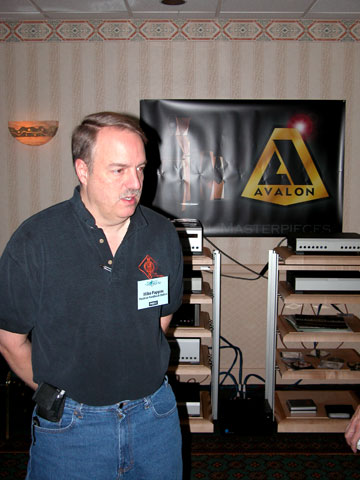
Mike Pappas discussed the demo recording in the Avalon room.
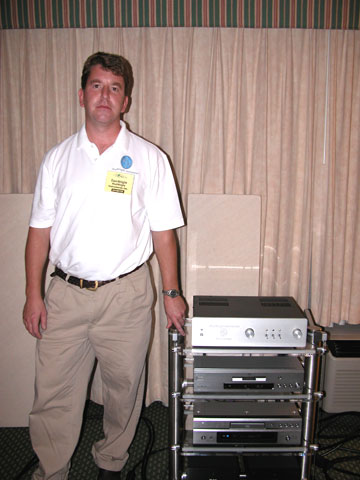
I was able to get to the Modwright room and hear Dan Wright's latest design work. The sound was good, and his design work had flourished since the last time that I had seen him. (Check out http://www.modwright.com for more details.)
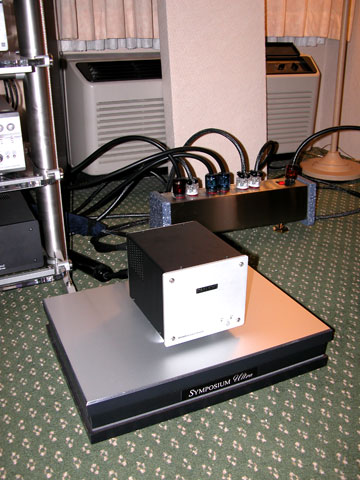
Dan was displaying with the Channel Islands Audio (http://www.ciaudi) D-200 200 WPC Class D monoblocks at a very reasonable $2299 per pair, resting on Symposium Ultra isolation platforms. In the background is an audioexcellenceaz Power Wing line conditioner (http://www.audioexcellenceaz.com).
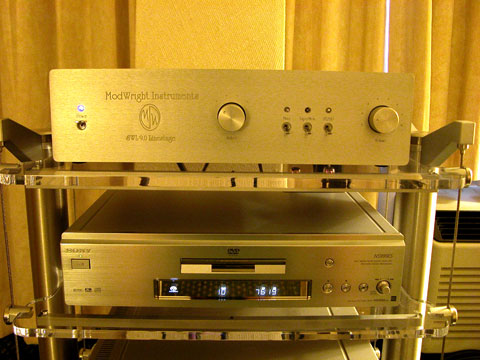
Dan's Modwright Instruments SWL 9.0 tubed preamp (top) …good sound, and a real value at $2200. Beneath that is Dan's modded Sony NS 999ES SACD player.
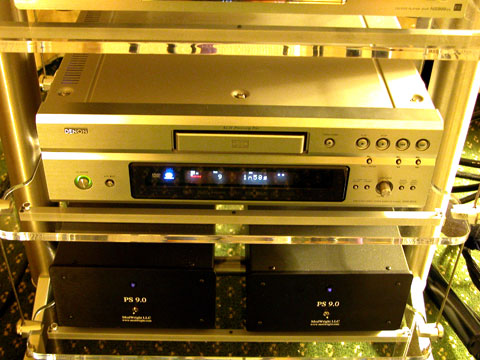
The Denon 3910 SACD/DVD player as modded by Dan; below that are a pair of the Modwright Power Supply 9.0's.
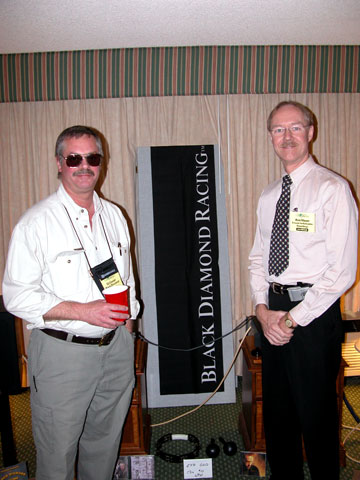
I was on the run, but I did get a chance to say hello to DJ Casser of Black Diamond Racing (left) and Ron Meyer of Encore Performance Recordings. Ron did a brief demo of his recordings; unfortunately, my time was very limited by this point in the show.
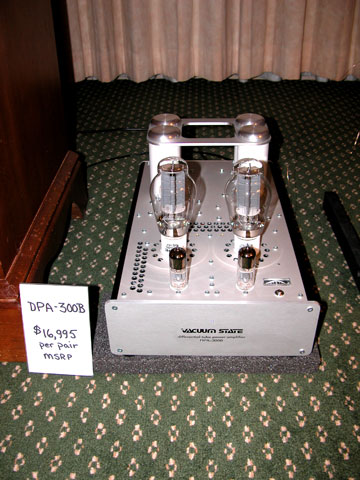
I was able to get to the Vacuum State Electronics room and finally see Allen Wright's DPA-300B monoblocks. Very pleasant to look at, though I had no time to listen for very long. We hope to review these here at PFO some time in 2006.
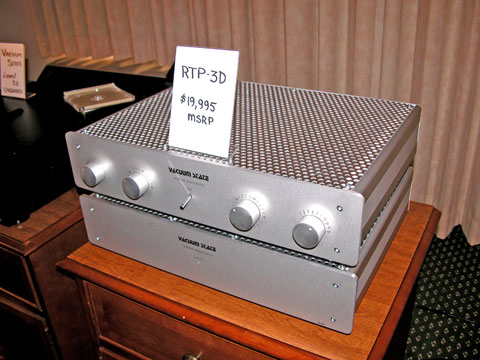
The Vacuum State Electronics RTP-3D preamp and power supply. Allen has done some unusual work in how he handles connections in these devices; this would also be part of a review package if we're able to review them in 2006.
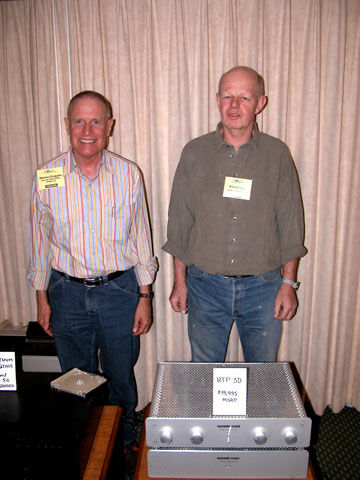
Warren Gregoire of Warren Gregoire LLC and Allen Wright of Vacuum State Electronics…two very good guys!
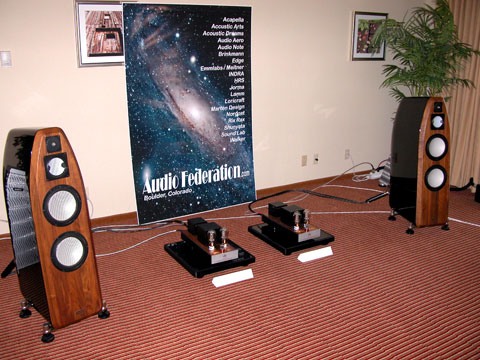
I was able to get up to the Audio Federation/Marten Design/EMM Labs/Meitner Design/Audio Aero room one more time before I left. This was another of the righteous rooms: LPs a-plenty via a Brinkmann, and a very fine EMM Labs front end. At this moment the Audio Note Kegons were in play, driving the Marten Design Coltranes. Good sound!
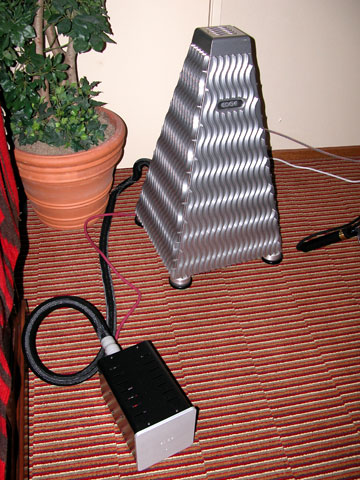
Edge solid state amplification was also on display…behold, the pyramid!
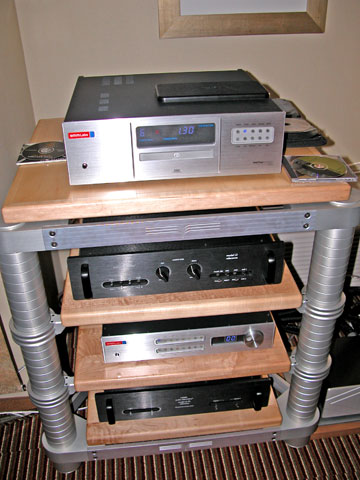
An EMM Labs front end, with Lamm preamplification in black.
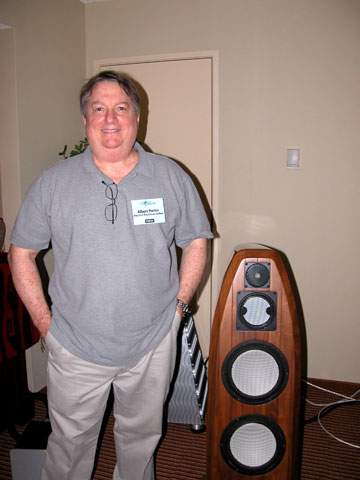
While in this room, I ran into PFO’s intrepid photographer and reviewer Albert Porter. He liked the sound of the Coltranes…so did I. (Though Albert is up to his sensibilities in a pair of Dali Megaline’s at home right now.) This was a good time to take a rare photo of the photographer.
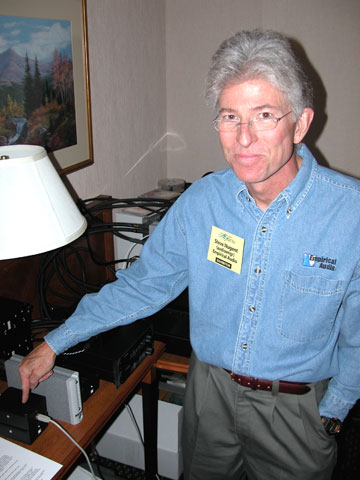
I also breezed by the Empirical Audio room, where my fellow Oregonian and audiobud Steve Nugent was demonstrating some interesting new interface products for computer-based music. The sound in Steve’s room is always good, and he’s very knowledgeable on the subject of computer interfaces and music. If this is your cup of tea, then you should get in touch with Steve.
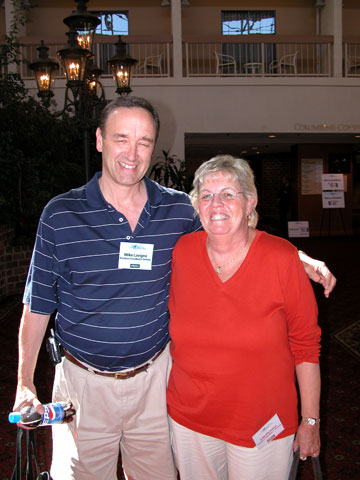
As we headed towards the door, Lila and I ran into PFO contributor Mike Lavigne. Mike’s a great fellow, and has terrific audio sensibilities. His listening room is a work of art….
And then we were out of time. Lila, Dave, Carol, Bryan and I all had to leave to catch out planes, long before I had a chance to give every room the attention it deserved. That’s always the way it is, unfortunately.
My picks for "the best I heard at RMAF 2005"? That’s easy enough.
On the turntable side of things, the Walker Audio/Red Rock Audio/Verity Audio/Silent Source Cables room was simply superb, a true oasis of music and sound throughout the show. Whenever I needed to re-charge my batteries and clear my head of the audio muzzies, I went back here. Kudos to Lloyd, Al, Fred, Gordon, and Julien for an absolutely terrific sonic presentation.
On the digital stereo side of the ledger, the Blue Light Audio/EMM Labs/Von Schweikert Audio/darTZeel/JENA Labs/Grand Prix Audio room was excellent. Jonathan and Kevin did a fine job of putting a lot of exceptional gear into their room, and showing what SACD could do…great work, guys!
The surround demos of Mike Pappas and Ray Kimber also come up for well-deserved praise. While using different approaches, both Mike and Ray showed that DSD provides us with a marvelous platform for future surround recording projects. This room and its DSD playback showed dynamics, spaciousness, and transparency that pushed back the boundaries of what’s possible in surround sound. Many thanks to Mike and Ray for their fine work in this important domain!
Special mention should be made of the Audio Federation room with its Brinkmann/EMM Labs/Audio Note/Coltrane combo was terrific sounding. Not only that, but they were playing REAL MUSIC in there! Radical concept! Definitely one of the top rooms that I heard at the show.
Likewise the deHavilland/Nola/Pranawire room deserves praise, since it was always musical, and had a reach that didn’t exceed its grasp.
I should also mention the Audio Unlimited/JM Lab/Focal/Pathos Acoustics/Kubla Sosna Cables room as being a pleasant relief from some of the excesses and sins of commission/omission in some other rooms.
And then we were out of time. Lila, Dave, Carol, Bryan and I all had to leave to catch out planes, long before I had a chance to give every room the attention it deserved. That's always the way it is, unfortunately.
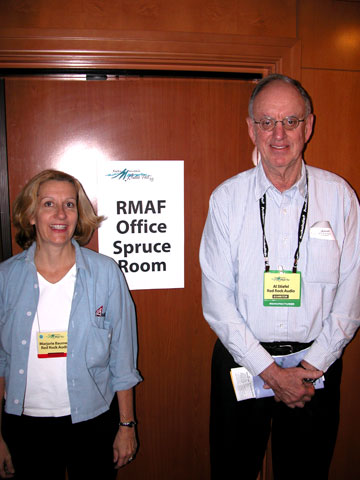
Last of all, I want to thank Marjorie Baumert and Al Stiefel once again for organizing this year's Rocky Mountain Audio Fest. They were terrific hosts, and handled a staggering workload to make it happen. With a doubling of exhibitors and an 80% increase in attendees, I'm hoping that they will do it again in 2006. As I've said before, the RMAF is an audio show that you don't want to miss.
Leave your calendar open for next year's even!
